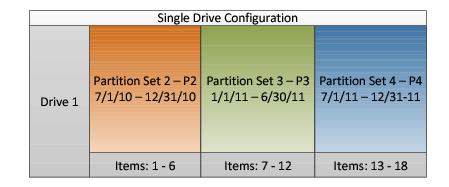Index management
|
• |
Overview
The Full Text Index is a collection of message and attachment data to facilitate fast and accurate search results based on queries. The Full Text Index is split into individual partitions, each of which indexes a subset of message or attachment data into a separate index directory. The items contained in each partition are defined by the Index Rollover Policy.
Multiple drives can be used to enhance indexing in the following ways:
|
• |
Redundancy: A secondary or failover partition is used as a backup to a primary partition. The secondary partition is used if there is a problem with the primary partition. |
|
• |
The following terms are used throughout this chapter:
|
• |
Partition set: A partition set is a group of shards that span a date range. The date range is approximately 180 days per drive. Depending upon how many drives you have configured, your partition set will consist of 1, 2, 3, or 4 shards. |
|
• |
Partition: A group of index files used to facilitate fast and accurate search results based on queries. |
|
• |
Shard: A shard contains a primary partition, and if failover is enabled a shard also contains a secondary (failover) partition. The number of shards is equal to the number of index drives selected, up to 4 drives. |
|
• |
Index: An index is a collection of message or attachment partition sets. The partition set name is based upon the date of the first item indexed in the set. When a new partition set is automatically created, it is defined based upon the Index Rollover Policy. |
Index topology
The following graphics show possible index configurations.
Configuring the Full Text Index
It is recommended to select the Default Configuration option on the Full Text Index Setup page. Using this option creates a default rollover policy based on time. The amount of time between rollovers depends upon the number of drives configured during the install, or added from the website. More than one drive results in failover becoming enabled. The rollover policy is used to determine when the current newest partition rolls over and a newly-created partition becomes the current partition. It also defines the configuration of the partitions.
The rollover policy created when selecting this option can be viewed and edited on the Index Rollover Policy page. Backup settings can be customized after the installation has completed.



